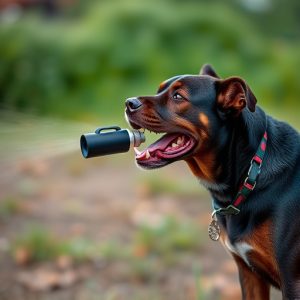Dog Defense Spray: Training, Selection, Application & Legalities
Dogs may attack runners due to territorial, fear, or pack protection instincts. Proper Mace spray do…….
Dogs may attack runners due to territorial, fear, or pack protection instincts. Proper Mace spray dog training focuses on conditioning dogs to associate running with negative but safe experiences through controlled desensitization and spray application during aggressive signs. Effective training requires understanding canine behavior triggers, positive relationships between runners and dogs, and enhancing outdoor safety. The effectiveness of dog deterrent spray like Mace depends on correct training techniques, involving handler and dog, timing, and distance. Selecting a defense spray with capsaicin, proper strength, and safety features is crucial. Regular practice conditions dogs to respect boundaries, prioritizing safety, adhering to local laws, and guided by professional trainers.
“Running into a dog while on your morning jog can be an intimidating experience, especially if the canine displays aggressive behavior. This article explores runners’ defense dog deterrent spray as a tool for self-protection. We delve into understanding dog behavior, highlighting why they attack and effective training methods to deter them. Learn about selecting the right spray, application techniques, and legal considerations. Discover professional tips on proper Mace spray dog training techniques to ensure safe and responsible usage.”
- Understanding Dog Behavior: Why They Attack and How to Deter Them
- The Role of Proper Training in Effective Dog Deterrent Spray Use
- Selecting the Right Dog Defense Spray: Ingredients, Strength, and Safety
- Application Techniques for Optimal Effectiveness: When and How to Spray
- Legal Considerations and Ethical Usage: Responsible Dog Deterrence Practices
Understanding Dog Behavior: Why They Attack and How to Deter Them
Dogs may attack runners for a variety of reasons, from territorial instincts to fear or protection of their pack (which could be perceived as including their owner). Understanding this behavior is key in developing effective deterrents. Proper Mace spray dog training techniques involve conditioning dogs to associate running with negative experiences. This can be done through controlled desensitization, where the runner maintains a safe distance and gradually reduces it over time, paired with the application of the spray when the dog shows aggressive signs.
Using proper Mace spray requires knowledge of trigger points and subtle cues in dog behavior. By teaching dogs to associate running with an unpleasant but not harmful experience, runners can enhance their safety while enjoying outdoor activities. This approach not only discourages unprovoked attacks but also fosters a more positive relationship between the runner and other canine companions they may encounter on their routes.
The Role of Proper Training in Effective Dog Deterrent Spray Use
The effectiveness of dog deterrent spray, like Mace, heavily relies on proper training for both the handler and the canine companion. Effective use requires understanding the right application techniques, timing, and distance to ensure safety and success. Well-trained dogs can learn to respond calmly to the scent or sensation of the spray, avoiding aggressive reactions. Training should involve positive reinforcement methods, teaching the dog an association between the spray’s activation and a specific command or signal from the handler. This helps the dog anticipate and comply with the intervention without fear or panic.
Proper mace spray dog training techniques also encompass scenarios where the spray is needed in real-world situations. Simulating potential threats during training allows dogs to develop confidence in their responses, understanding when to retreat, deter, or protect based on their handler’s cues. This comprehensive approach ensures that both dog and handler are prepared to handle unexpected encounters effectively while minimizing harm to people or other animals.
Selecting the Right Dog Defense Spray: Ingredients, Strength, and Safety
Selecting the right dog defense spray involves considering its ingredients, strength, and safety features. Look for products containing capsaicin, a natural ingredient derived from chili peppers that causes temporary yet effective irritation, making it a popular choice in dog deterrents. The strength of the spray should be suitable for your needs; lighter options are ideal for training purposes, allowing dogs to learn without causing undue harm. Proper Mace Spray Dog Training Techniques include using it responsibly and consistently during interactions with potential threats. Start by introducing the spray in a controlled environment, creating an association with positive reinforcement to condition your dog’s response. Gradually increase the intensity of the stimulus, always ensuring safety and following local laws regarding the use of such devices. Regular practice will help your dog understand the boundaries and behaviors that are acceptable or unacceptable.
Application Techniques for Optimal Effectiveness: When and How to Spray
For optimal effectiveness, understanding proper Mace spray dog training techniques is key. The timing and application method significantly impact its success as a deterrent. When training your dog, it’s crucial to begin with positive reinforcement. Reward your dog for calm behavior and good choices before introducing the spray. This creates an association between staying still and being rewarded, making future deterrence more effective.
Spraying should be a last resort when your dog displays persistent unwanted behaviors like barking or aggression. Aim for short bursts at close range, typically 3-6 inches away from their face, to minimize misting on you or other pets. The goal is to create an intense but brief sensation that disrupts and interrupts the behavior pattern, teaching your dog a new response. Always follow local laws and regulations regarding the use of such deterrents and consult with a professional trainer for guidance tailored to your dog’s unique needs.
Legal Considerations and Ethical Usage: Responsible Dog Deterrence Practices
When considering dog deterrent spray, such as proper Mace spray for dog training techniques, it’s crucial to navigate legal and ethical considerations. Each region has specific laws governing the use of such products, with some prohibiting their use on animals altogether. Even in areas where permitted, responsible practices are paramount. This includes ensuring the spray is a last resort, only deployed when other non-lethal methods have failed or aren’t suitable.
Ethical usage demands that dog owners and trainers administer the spray responsibly, prioritizing the animal’s well-being. Proper Mace spray dog training techniques should involve quick bursts at the ground or legs, avoiding direct contact with the face, which can cause panic or distress in dogs. Regular, positive reinforcement-based training methods remain the cornerstone of effective and ethical dog behavior modification.
In conclusion, while runners’ defense dog deterrent spray can be a powerful tool in certain situations, understanding dog behavior, proper training techniques using mace spray, and ethical usage are paramount. By selecting the right ingredients, applying them safely, and adhering to legal guidelines, runners can effectively deter potential attacks while promoting responsible dog ownership. These practices ensure both personal safety and the well-being of canine companions in our communities.


